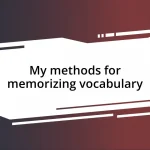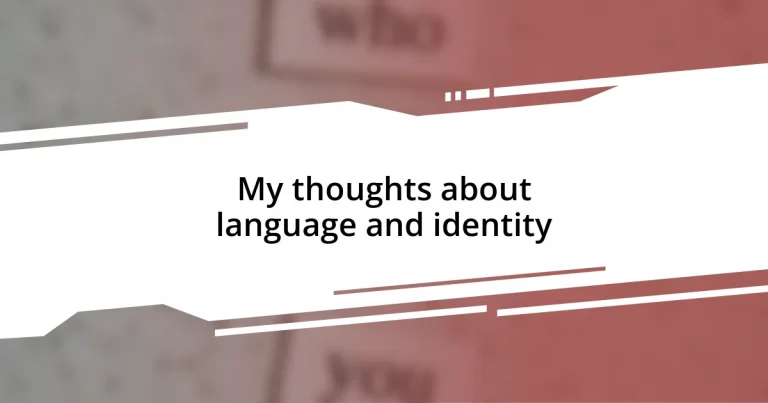Key takeaways:
- Language significantly influences identity, shaping how we perceive ourselves and connect with culture.
- Experiencing new languages fosters personal growth and emotional exploration, while moments of communication hesitation enhance resilience.
- Preserving languages faces challenges such as globalization and dwindling speakers, highlighting the need to celebrate linguistic diversity and local variations.
- Engaging with diverse languages fosters empathy and understanding, essential for navigating our interconnected world.
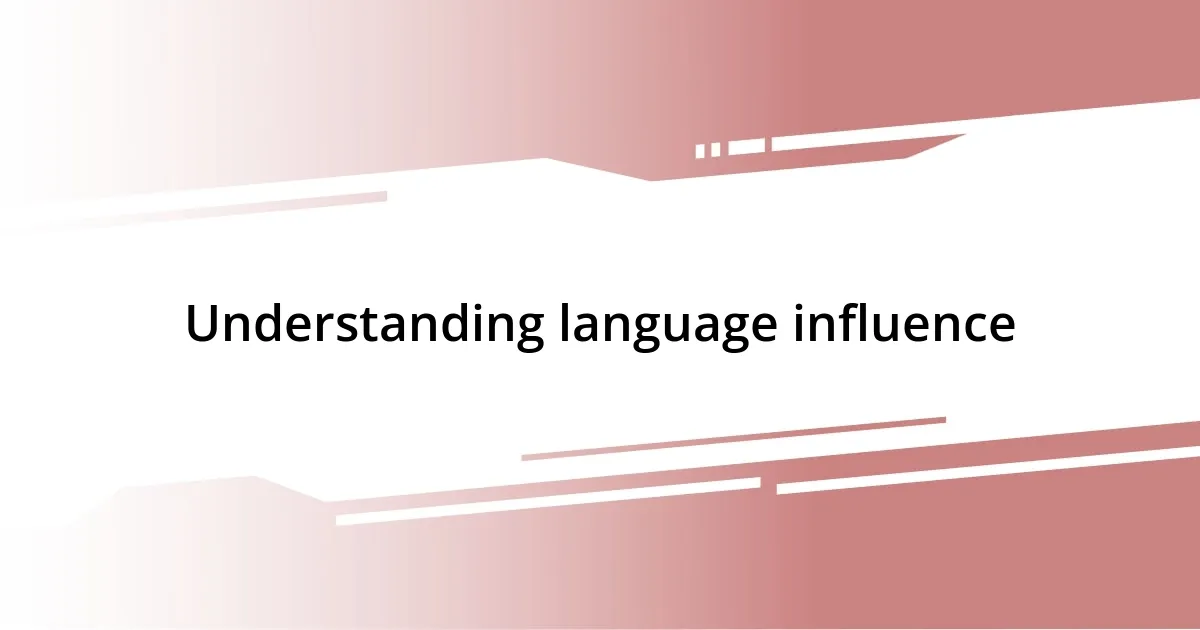
Understanding language influence
Language is such a powerful tool that shapes not only how we communicate but also how we see ourselves. I remember a time when I was learning a new language; it felt like stepping into a new skin. Suddenly, my identity shifted ever so slightly as I realized that my thoughts could sound different depending on the words I chose to express them. Isn’t it fascinating how a simple change in language can alter our perspective?
When I think about language influence, I can’t help but reflect on those moments of miscommunication that left me feeling vulnerable. One time, I was in a social setting where English was the main language, and I struggled to find the right words. That feeling of being slightly out of place emphasized how much we rely on language to connect and belong. Have you ever felt that disconnect? It’s a reminder that language is more than just vocabulary; it’s a bridge to understanding our culture and heritage.
Moreover, consider how language influences our internal dialogue. I’ve noticed that when I speak my native language, my emotions flow more freely, almost as if I tap into a deeper part of myself. It makes me wonder, how different would our thoughts be if we consistently expressed ourselves in a different language? This exploration might just unveil layers of our identity we never knew existed.
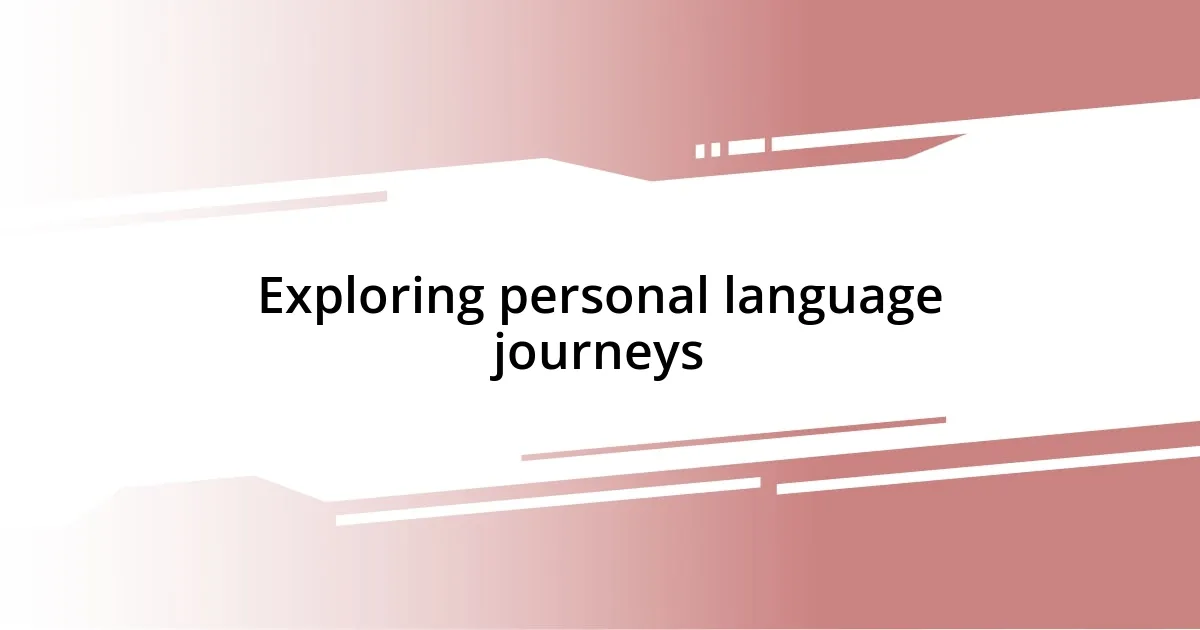
Exploring personal language journeys
As I look back on my own journey with language, it’s clear that each new tongue I’ve wrestled with brought its own unique set of challenges and rewards. I vividly recall my first encounter with another language while I was volunteering abroad. At first, I felt like an imposter, fumbling over unfamiliar sounds and struggling to convey my thoughts. But with every little success—like ordering my favorite dish or sharing a joke—I found my confidence blooming. It struck me how these small victories were reshaping my identity and expanding my worldview.
- Language barriers can be powerful teachers, revealing our vulnerabilities and strengths.
- Embracing a new language can lead to profound connections with others and deepen our understanding of different cultures.
- Moments of hesitation in communication often serve as catalysts for personal growth, pushing us to step outside our comfort zones.
- The emotional weight carried in our native language can sometimes feel like an anchor, grounding us in our identity, while new languages offer a chance to reinvent ourselves.
- Each phrase learned becomes a new thread in the fabric of who I am, weaving together experiences that shape my sense of self.
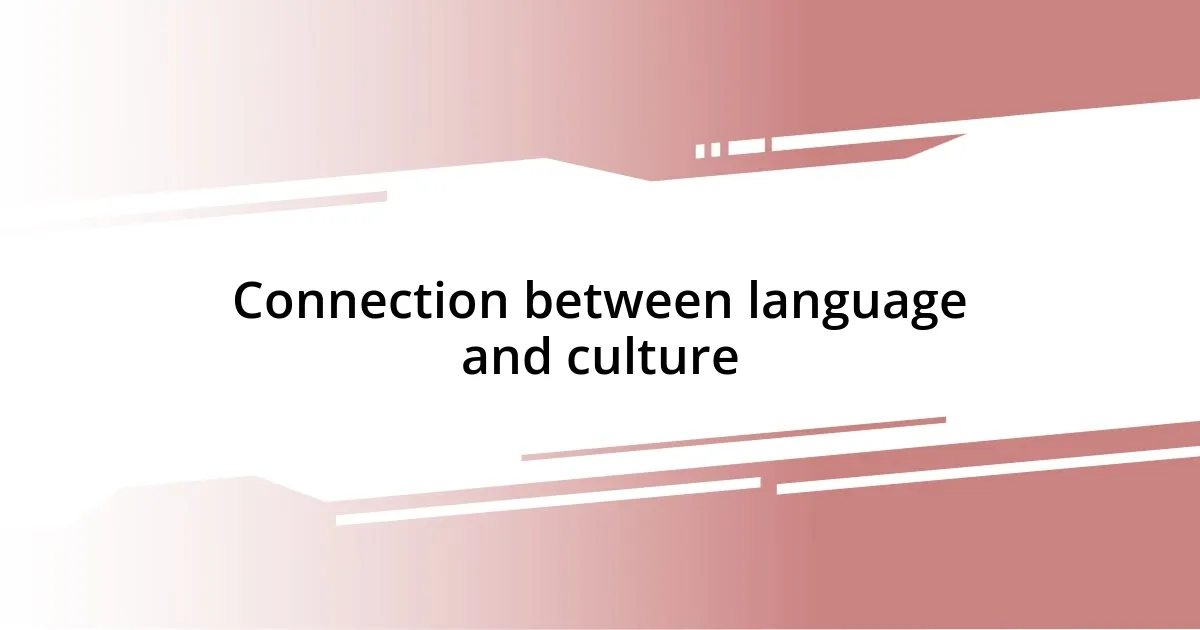
Connection between language and culture
Language is intricately tied to culture, acting as both a vessel for and a reflection of our shared experiences. I remember the first time I celebrated a cultural festival in another country, and the local language added layers of meaning to each ritual. Hearing greetings and blessings in that language made the experience feel more authentic and immersive. It was a reminder that language is a living part of culture, transforming words into emotions that connect us deeply.
When I think about the nuances in expressions depending on culture, it hits me that certain phrases can’t even be translated directly; they lose their essence otherwise. For instance, the warmth of a Spanish “sobremesa,” which refers to the time spent chatting around the table after a meal, holds a significance that English words can’t encapsulate. These unique expressions anchor us to cultural practices and traditions, showing how language doesn’t just reflect our identity—it actively shapes it.
Every time I navigate between languages, I find myself shifting between different cultural lenses. I recall feeling like a chameleon—when speaking my native tongue, I embrace familiarity and comfort. Switching to a new language, however, requires me to adopt a different persona, often leading to unexpected perspectives. Isn’t it intriguing how our identities can subtly shift in response to the language we’re using at any given moment? This fluidity underscores the powerful bond between language and culture, illuminating the way we perceive ourselves and our place in the world.
| Aspect | Description |
|---|---|
| Language Shapes Identity | Language influences how we see ourselves and our roles within our culture. |
| Nuances in Expression | Some cultural phrases embody meanings unique to their context, highlighting the depth of language. |
| Cultural Lens | Shifting languages can change our perspective and how we engage with the world around us. |
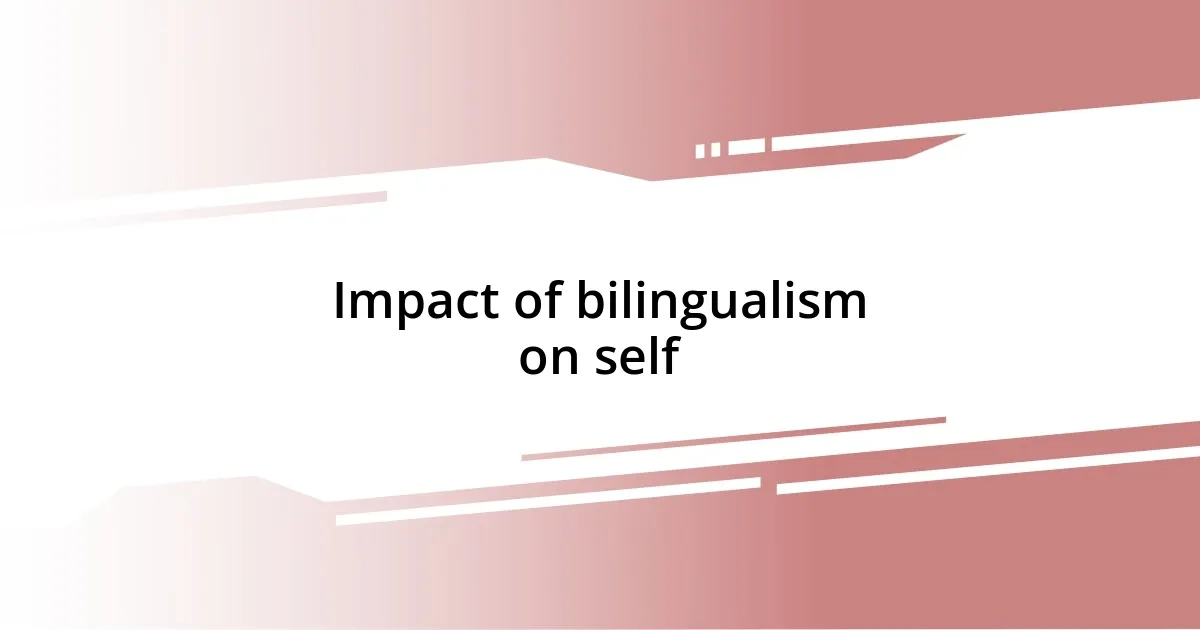
Impact of bilingualism on self
Bilingualism has profoundly influenced my self-image and confidence. I remember the first time I spoke Spanish fluently in a group setting; it was exhilarating. I felt like a bridge between worlds, connecting with people who had once seemed distant. This experience allowed me to see that mastering another language doesn’t just mean switching words—it’s about embodying a different way of being.
But it’s not just about the practicalities of communication. Shifting between languages often evokes a unique emotional landscape. When I speak in my native tongue, I tap into a well of memories—family gatherings, childhood stories, and intimate conversations. In contrast, when I express myself in a second language, there’s a refreshing sense of liberation. Isn’t it fascinating how our emotions can transform with the words we use? It’s a reminder that bilingualism isn’t just a skill; it reshapes how we relate to ourselves and others.
Additionally, I find that my bilingual identity often invites vulnerability. There are moments of pure uncertainty—like when I’m caught between wanting to express my thoughts perfectly while fearing I might misstep. Yet, those moments create a powerful tension that pushes me to grow. I’ve learned that embracing the awkwardness and imperfection in my language journey has made me more resilient and open to learning from mistakes, ultimately deepening my self-awareness.
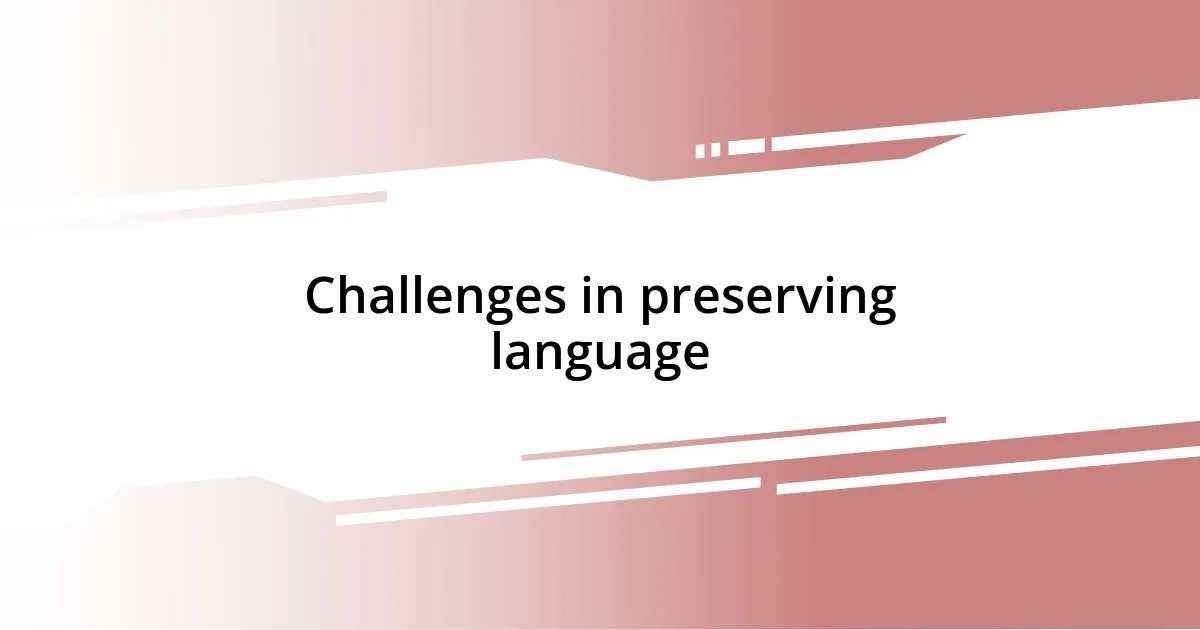
Challenges in preserving language
One major challenge in preserving language is the dwindling number of speakers. I once attended a workshop on endangered languages, where I was struck by the statistic that only a handful of people might speak certain indigenous dialects. It truly hit home when a participant shared stories of their grandmother—the last fluent speaker of their tribe’s language—struggling to pass it down to younger generations. How can we keep these languages alive when fewer and fewer people are connected to them?
Another aspect that complicates language preservation is the influence of globalization. I often reflect on how dominant languages, like English and Mandarin, overshadow minority languages in media and education. I remember reading about a small community that once thrived on its unique language, now places more value on learning English for job opportunities. It feels disheartening to see cultural richness sidelined in favor of practicality. Is it possible to strike a balance between adapting to the global stage and honoring our linguistic roots?
Lastly, the challenge of language standardization can’t be overlooked. I find it fascinating that even within a single language, variations can emerge that might not be recognized by formal institutions. For instance, my cousin from a different region uses phrases that I’ve never heard before! These local nuances can sometimes get lost when efforts are made to create uniformity in language teaching. Isn’t it vital to celebrate these differences rather than erase them? Preserving a language means embracing all its forms, quirks, and rich history.
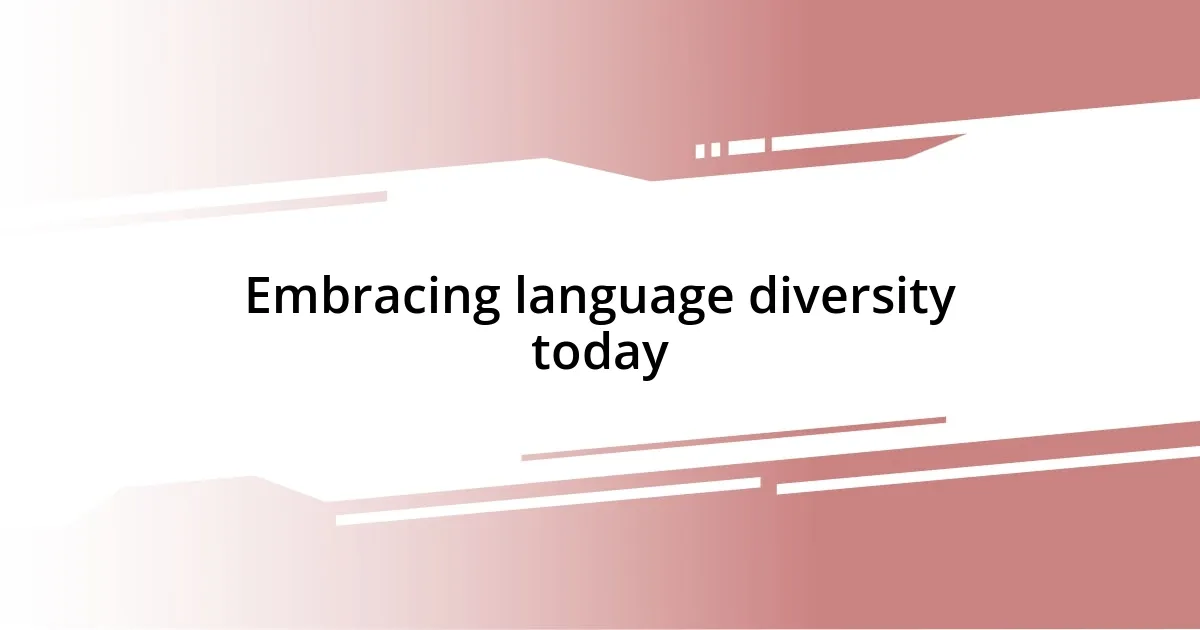
Embracing language diversity today
Creating an atmosphere that embraces language diversity today is essential in our increasingly interconnected world. I remember walking into a multicultural festival, surrounded by booths showcasing different languages and cultures. Each conversation I had opened up a different perspective, reminding me how language can act as a gateway to understanding and appreciating our differences. Isn’t it incredible how just a few words can spark an entire dialogue that enriches our lives?
As I navigate my own journey with languages, I often find myself drawn to community spaces where diverse tongues thrive. Recently, I joined a local language exchange group, where I met people from various backgrounds eager to share their stories. The energy in the room was palpable, as laughter and a mix of languages filled the air. These moments highlight the beauty of human connection, with each slip of the tongue or unfamiliar accent melting away the barriers we often place between ourselves.
However, despite these enriching experiences, I sometimes wonder how many of us truly make the effort to engage with languages outside our comfort zones. During my travels, I’ve noticed how a genuine attempt to speak the local language can open doors that would otherwise remain shut. It’s humbling to realize that embracing linguistic diversity isn’t just beneficial—it’s a necessity for fostering empathy and understanding in our global community. What would it take for more of us to take that step? Perhaps a little curiosity goes a long way.







